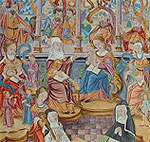 |
| Detail from the Salzinnes Antiphonal, an illuminated manuscript dated 1554. |
The Cistercian convent that once stood in the village of Salzinnes in Belgium has been gone so long it’s not even a memory.
But the sweet sound of women’s voices that once drifted out of abbey windows and over fields will soon be heard again — with the help of HÂţ» University musicologist Jennifer Bain. In a concert presented by Scotia Festival of Music, the all-female vocal ensemble Anonymous 4 will perform choral music from the Salzinnes Antiphonal on Saturday, Oct. 27, 7 p.m. at Saint Mary’s Basilica.
“I have a sense of what it will sound like, but to hear it in a setting like Saint Mary’s Basilica will be incredible,” says Dr. Bain, associate professor of music, whose area of specialization is medieval music.
Collected in a rare illuminated manuscript circa 1554, the choral music would have been sung by nuns in straightforward harmonies, not unlike Gregorian chant. The songs, in Latin, marked special occasions in the church, including feast days for saints. It’s believed William Walsh, archbishop of Halifax and an avid art collector, acquired the Salzinnes Antiphonal during his travels in Europe in the 1840s.
|
It’s unusual in that it’s so personal. There are 34 portraits of nuns who are identified by name and family coats of arms, including Julienne de Glymes, prioress of the Cistercian Abbey of Salzinnes, who is thought to have commissioned the manuscript in commemoration of the abbey’s 350th anniversary. The book gives a sense of the lives of the nuns, in their white habits and black wimples, at prayer, at work, and in song.
Judy Dietz, former curator at the Art Gallery of Nova Scotia, rediscovered the manuscript at the Patrick Power Library at Saint Mary’s University when she was preparing an exhibition of sacred artifacts at the gallery a few years ago. Now retired, Ms. Dietz plunged into researching the history of the manuscript — a journey that took her to the cathedrals and convents of Belgium and the secret archives of the Vatican.
“It will be so wonderful to hear this music — this will be the first public performance of this music, oh, in about 450 years,” says Ms. Dietz. “I know my mind will go
back to what it would have been like, to the nuns and to Julienne who actually commissioned the manuscript. I’m sure it will be very emotional.”
While Ms. Dietz researched the history, she approached Ms. Bain for help with the music.
“Music was central to the lives of these women in monastic settings,” explains Ms. Bain. “They would have spent literally hours every day singing together.”
Dr. Bain transcribed the music for Saturday’s concert and asked Anonymous 4 to perform it. Although supposedly on hiatus, the chart-topping, New York-based ensemble was keen to take on the challenge. (The group’s album Anonymous Angels hit number one on Billboard’s classical charts in 2004.)
“They’re really exceptional performers,” says Dr. Bain. “They’re also quite pioneering in that there are very few female groups doing chant now — we think of monks doing this, not nuns, but but back a few centuries ago, women sang this music too.”
A panel discussion on the manuscript itself will take place Friday, Oct. 26, from 1:30 p.m. to 4:30 p.m. at the Art Gallery of Nova Scotia. Specialists in the field of art history, music and Latin, including Ms. Dietz and Dr. Bain, will discuss the significance of the exquisitely decorated 16th-century manuscript. The discussion will also include a tour of the exhibition, An Expression of Faith: Sacred Art of Centuries Past, which has been re-mounted in conjunction with the Salzinnes Antiphonal celebrations.
 |

 Ěý
Ěý